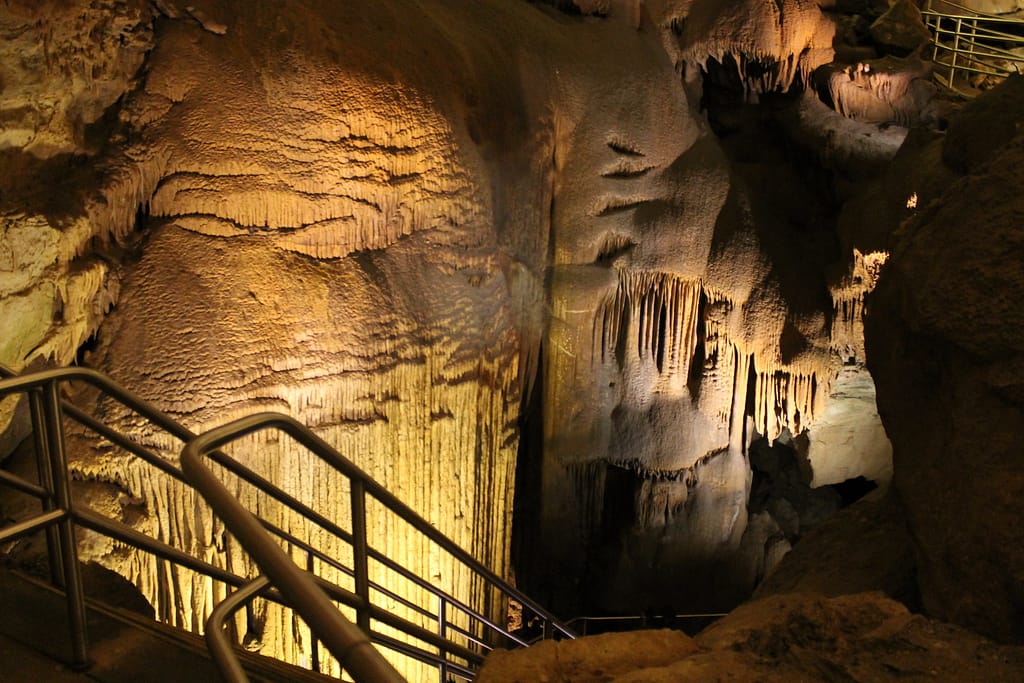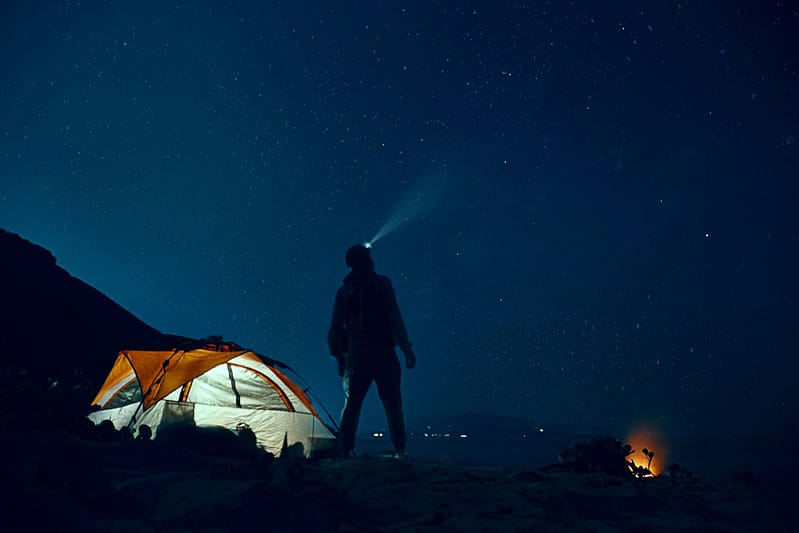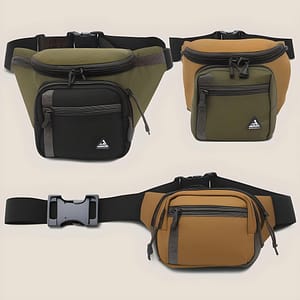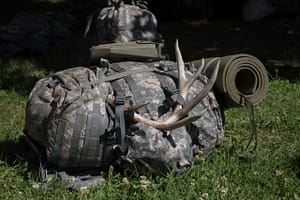Mammoth Cave camping offers a thrilling adventure for outdoor enthusiasts. Explore the vast underground labyrinth and immerse yourself in the beauty of nature.
Mammoth Cave National Park in Kentucky hosts a subterranean wonderland, home to more than 400 miles of explored passageways.
From above, lush forests and rolling hills lure campers, but it’s what lies below that captivates—the vast, echoing chambers of Mammoth Cave beckon adventurers to experience a world carved by water over millennia.
Now that’s a call to adventure.
Setting Up Camp: Mammoth Cave Basics
When you’re heading to Mammoth Cave, remember it’s not just about picking a spot and pitching a tent. You gotta be mindful of your surroundings, secure the proper permits, and yes – respect the diverse biosphere. This ain’t your backyard campout, so be sure to study up on the specific regulations and designated camp zones before you break out the s’mores.
Then, after you’ve found your primo campsite, it’s all about leaving no trace behind. Campfires? Think twice—use designated fire rings or grills. Remember, this place is a natural sanctuary, and it’s on us campers to keep it pristine. So keep it tight, pack out what you pack in, and let’s keep Mammoth Cave epic for the next thrill-seekers.
Choosing Your Campsite
Alright, first thing’s first—location, location, location. You’ll want a spot that’s safe and legal, not to mention aesthetic. Keep an eye out for level ground to nestle your tent on.
Now let’s talk practicality. You’re in nature’s massive masterpiece, so think proximity to trails, water sources, and amazing views. Close, but not too close—you need some privacy and peace, right?
Mammoth Cave National Park has over 13 backcountry campsites.
Final pro tip: Consider the campsite’s exposure. Sites with shade shelter you from the sun’s zeal while openings to the starry sky amp up the zen. And hey, if you’re lucky, you might just snag a site with a view that’s absolute fire.
Reservation Tips & Tricks
Snagging the perfect campsite at Mammoth Cave can feel like striking gold – be strategic and quick when reservations open up.
- Book early: Popular sites fill up fast, especially during peak season.
- Know the seasons: Weather varies, so your dream spot in summer might not be ideal in winter.
- Check site details: Note the amenities, like fire rings, picnic tables, and toilets.
- Be flexible: If your first choice is gone, having a plan B (and even C) can save the day.
- Group dynamics: Larger sites for groups may require advanced booking and additional fees.
- Cancellation policies: Understand them in case plans go sideways.
Remember, create an account beforehand to speed up the checkout process when you book.
Luck favors the prepared – use alerts and recommendations to gain an edge on choice reservations.
Gear Up for Cave Exploration
Before you dive into the subterranean wonderland of Mammoth Cave, gear up with the essentials. Trust me, it’s a different ball game under the earth’s surface. You’ll need a sturdy pair of hiking boots to navigate rocky terrain and a headlamp to cut through the pitch-black darkness. Layer up with breathable, moisture-wicking clothing to adapt to the unpredictable temps down below. And don’t forget your sense of adventure – the cave’s twists and turns can lead to some epic discoveries. But remember, safety first; never go spelunking alone.
Essential Spelunking Gear
Delving into the cavernous realm of Mammoth Cave necessitates some key gear essentials. Without these, you’re basically a fish out of water – or more aptly, a human out of sunlight.
- Headlamp with extra batteries: This isn’t just to keep your hands free, it’s your primary source of light down there.
- Helmet: Protect your noggin from low-hanging rocks and unexpected bumps.
- Gloves: Keep your hands safe from sharp rocks and provide extra grip.
- Sturdy hiking boots: Ankle support and grip are non-negotiable on rugged cave floors.
- Moisture-wicking clothing: Stay dry and comfortable in the humid cave environment.
- Personal first-aid kit: For those just-in-case moments when you need a quick fix.
- Hydration pack or water bottles: Staying hydrated is absolutely crucial, even underground.
Your spelunking success hinges on preparation and having the right tools at your disposal.
Don’t skimp on your gear choices; quality spelunking equipment is an investment in safety and enjoyment. With the right prep, you’ll not only emerge from the depths unscathed but also with stories that’ll light up any campfire chat.
What to Wear Underground
Dressing for a subterranean adventure in Mammoth Cave means preparing for a cool, damp, and often rugged environment.
- Layered clothing: Start with a moisture-wicking base layer, add an insulating mid-layer, and top it off with a rugged outer layer.
- Durable pants: Choose something that can handle abrasion from rocks and is flexible enough to allow for easy movement.
- Comfy, closed-toe shoes: Overlook the sandals and flip-flops; you’ll want protective, closed-toe shoes with a non-slip sole.
- Spare change of clothes: After the expedition, you’ll be grateful for a dry set of clothes to change into.Remember, it can get nippy underground, so those extra layers aren’t just a suggestion—they’re essential for comfort.
Keep it practical and protective down there. It’s about balancing warmth with mobility, so don’t go overboard, but don’t underprepare either.

Navigating Mammoth Cave Park Trails
Trekking through Mammoth Cave National Park is like stepping into a different realm, where each trail has its own personality waiting to be unraveled. From laid-back scenic strolls to pulse-quickening backcountry trekking, there’s a path for every type of adventurer. Keep your eyes peeled and your map handy – the park’s trails twist and turn, leading to secret spots that are rich with history, unique geological formations, and glimpses of the diverse wildlife that call this place home. And remember, some routes can get pretty rugged, so lace up those hiking boots tight and get ready to immerse in nature’s epic display.
Must-See Cave Tours
Ready to explore the depths of Mammoth Cave? Trust me, it’s an underworld of surreal beauty and historic whispers. We’re not just talking about a few stalactites and stalagmites here – this place has stories to tell, and the tours bring them to life in epic ways.
First off, the Frozen Niagara Tour is a knockout. Picture a cascade of flowstone that’s perpetually in suspended animation. Short, sweet, and visually stunning.
Want something more extensive? Go for the Domes and Dripstones Tour. A journey showcasing what nature crafts over millennia – think massive domes and delicate formations. It’s like stepping into a subterranean sculpture garden where geology meets artistry, and every turn is a surprise.
For the trek-hungry and history buffs, the Historic Tour serves up a slice of the past as you meander through paths once walked by early explorers. Then there’s the Wild Cave Tour – it’s not for the faint of heart. Imagine crawling, squeezing, and climbing your way through the cave’s undeveloped sections. It’s as close as you’ll get to feeling like an explorer of old, discovering uncharted territories. If you’re craving that raw, adrenaline-fueled experience, this is your jam. Just remember, “comfortable” isn’t in the vocabulary for this wild journey.
Hiking Above Ground
The surface isn’t just a pretty façade.
Above, the rolling hills beckon with verdant landscapes. Trails carve through forest and over limestone bluffs, offering panoramas that compete fiercely with the subterranean wonders. Here, you don’t just traverse a layer of earth — you are witness to a living tapestry that meshes with the sky. Whether it’s the rustle of leaves or the distant call of birds, nature’s soundtrack is omnipresent.
You might even encounter indigenous wildlife on your trek.
Every trail tells its own tale, a blend of geology and history. Some paths reveal the impact of weathering over centuries; others whisper stories of Native Americans and early settlers. It’s a trek through time, creating connections with those who tread these grounds before us.
Not all treasures are concealed beneath the surface. With trails meticulously maintained, threading through diverse ecosystems from damp caves to hardwood forests, this top-side adventure is a monumental slice of the Mammoth Cave experience. You might just find these vistas rivaling the cave’s own marvels – but let’s keep that between us.
Campsite Enjoyment and Safety
When you’re breathing in that fresh, woodsy air, remember that campsites are shared respites nestled in nature’s embrace. To maintain their serenity and ensure everyone has a stellar time, be mindful of camp etiquette—keep noise to a whisper after dark, leave no trace, and always be attentive to fire safety. There’s something magical about a campsite where the laughter of friends and the crackle of a campfire coexist in harmony with the forest’s whispers.
Maximizing your fun means playing it smart. Be watchful for local fauna that might stroll through camp, store food securely to avoid any uninvited nighttime visitors, and stay weather-aware. After all, being prepared is the ultimate secret for transforming a good camping trip into a great adventure.
Campfire Do’s and Don’ts
Starting a crackling campfire? Absolutely, but do it responsibly. Before sparking up, ensure you’re using established fire rings or pits and keeping flames under control. Wildfires are no joke, so treating every spark with respect is non-negotiable.
Use local wood. Transporting lumber across regions can introduce pesky, non-native pests.
First-time fire-builder? No sweat. Keep your fire small and manageable, and have water nearby (think safety blanket but wetter). You’ll thank yourself later.
Don’t be the person that leaves their fire unattended. Always watch your blaze, even if it’s just smoldering embers. Unexpected gusts of wind? They’re sneaky.
Remember, when it’s time to call it a night, douse your fire with water, and stir those ashes. Make sure it’s cold to the touch. Only when you’re certain the fire’s out can you hit the hay with peace of mind.
And lastly, gotta stick to the rules of the park. Some nights are just too dry for fires. When that’s the case, embrace the dark, starlit sky instead—nature’s own nightlight.
Wildlife and Leave No Trace Principles
Hey, did you know Mammoth Cave is a hotspot for diverse wildlife? Respect their space while camping to keep the ecosystem balanced and thriving.
Since 2016, the Leave No Trace Center for Outdoor Ethics recommends seven principles to minimize our impact. They’re like the golden rules for nature lovers: don’t mess up the place you’re enjoying.
So, when you’re setting up camp, think about the critters’ homes you’re visiting. Store your food securely, and keep your snacks to yourself—feeding wildlife can harm their health and alter natural behaviors.
While exploring the great outdoors, stick to the trails and pack out what you pack in. Leaving even biodegradable stuff like apple cores can affect the local flora and fauna. Let’s keep it pristine, folks.
Seriously, take only photographs, leave only footprints—that’s the camper’s mantra. Follow these guidelines, and your outdoor adventures will help ensure Mammoth Cave stays wild and wonderful.

Is camping allowed year-round at Mammoth Cave?
Yes, camping is allowed year-round at Mammoth Cave National Park. Whether you prefer the warmth of summer or the tranquility of winter, you can pitch your tent or park your RV and enjoy the beauty of this enchanting destination throughout the year.
Mammoth Cave offers a variety of camping options to suit your needs. The park features several campgrounds, each with its own unique charm. From the primitive campsites at Houchin Ferry Campground to the more modern amenities at Maple Springs Campground, there’s something for every type of camper.
For those seeking a true wilderness experience, backcountry camping is also available in designated areas. This allows you to immerse yourself in the untamed beauty of the park and escape the hustle and bustle of everyday life.
While camping at Mammoth Cave, you’ll have the opportunity to explore the park’s numerous trails, witness breathtaking views, and discover hidden gems along the way. Whether you’re a hiking enthusiast or just enjoy leisurely strolls, there’s a trail suited to your preferences and skill level.
What is the weather typically like for camping at Mammoth Cave?
The weather at Mammoth Cave National Park can vary throughout the year, making it important to come prepared for a range of conditions. Located in the beautiful state of Kentucky, the park experiences distinct seasons, each with its own unique charm.
Summer
In the summer months, camping at Mammoth Cave is a delight for outdoor enthusiasts. With warm temperatures ranging from the mid-70s to mid-80s Fahrenheit (24-29 degrees Celsius), it’s the perfect time to explore the park’s vast network of hiking trails. However, it’s important to note that summer also brings the occasional afternoon thunderstorm, so packing a lightweight, waterproof rain jacket is a wise choice.
Autumn
As autumn settles in, the weather at Mammoth Cave starts to cool down, providing a picturesque backdrop for camping. Temperatures range from the mid-40s to mid-60s Fahrenheit (7-18 degrees Celsius), creating a pleasant environment for hiking and enjoying the fall foliage. Layering up with a cozy sweater and packing a pair of sturdy hiking boots will ensure you make the most of your outdoor adventures.
Winter
Winter brings a tranquil atmosphere to Mammoth Cave, as snow blanketing the landscape creates a serene and peaceful setting. Temperatures during this time often range from the low 20s to the mid-40s Fahrenheit (-6 to 7 degrees Celsius). It’s important to dress warmly, with insulated clothing, hats, gloves, and waterproof boots to stay comfortable in the chilly weather. Don’t forget to bring a thermos filled with a hot beverage to keep you warm during your winter hikes.
Spring
Springtime at Mammoth Cave is a wonderful season to witness the park come back to life. Temperatures start to climb, ranging from the mid-50s to mid-70s Fahrenheit (13-24 degrees Celsius), and colorful wildflowers begin to bloom. With nature awakening all around, it’s a great time to explore the diverse plant and animal life. Remember to pack sunscreen, a hat, and insect repellent to stay protected during your outdoor explorations.
Are there guided camping tours available at Mammoth Cave?
Yes, there are guided camping tours available at Mammoth Cave National Park. These tours offer a unique opportunity to explore the stunning natural beauty of the cave system while enjoying the experience of camping in the great outdoors.
During the guided camping tours, you will have the chance to hike through the park’s scenic trails, learn about the history and geology of Mammoth Cave, and witness breathtaking underground formations. Expert guides will lead you on an unforgettable journey, sharing their knowledge and ensuring your safety throughout the experience.
Camping at Mammoth Cave allows you to immerse yourself in nature, disconnect from the hustle and bustle of everyday life, and connect with the serenity of the wilderness. The campgrounds provide a range of amenities to enhance your camping experience, including designated campsites, fire rings, and picnic tables.
Whether you are a seasoned camper or new to the world of outdoor adventure, the guided camping tours at Mammoth Cave offer a fantastic opportunity to explore one of the world’s most incredible cave systems. So pack your camping gear, grab your sense of adventure, and get ready to embark on a journey like no other at Mammoth Cave National Park.





